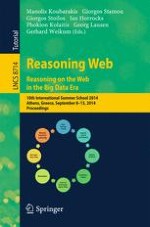2014 | Buch
Reasoning Web. Reasoning on the Web in the Big Data Era
10th International Summer School 2014, Athens, Greece, September 8-13, 2014. Proceedings
herausgegeben von: Manolis Koubarakis, Giorgos Stamou, Giorgos Stoilos, Ian Horrocks, Phokion Kolaitis, Georg Lausen, Gerhard Weikum
Verlag: Springer International Publishing
Buchreihe : Lecture Notes in Computer Science
